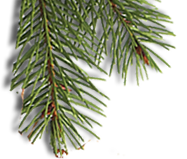
11th Hour Gulch is said to take its name because that is the only time it receiveds any sun. This ice formation begins growing in mid-fall from a tiny flow of water above. It is about 60 tall, 40 feet wide and several feet thick.
|
|
Pioneer trout fishermen used the former Canyon rail system to reach favorite casting spots. Trout in Spearfish Creek are not native but were brought from Colorado to a U.S. Bureau of Fisheries hatchery (now the historic D.C. Booth) at Spearfish in 1899.
Spearfish Creek averages 29 feet wide and, at this particular interpretive stop, there are abundant numbers of Rainbow, Brown and Brook Trout.
Eastern Deciduous Forest influence, such as Birch and Aspen, can be seen throughout this area; as can Rocky Mountain Forest vegetation. Beneath the overhanging branches of the Ponderosa Pine grows an abundance of species, limited only by the density of canopy above.
|


